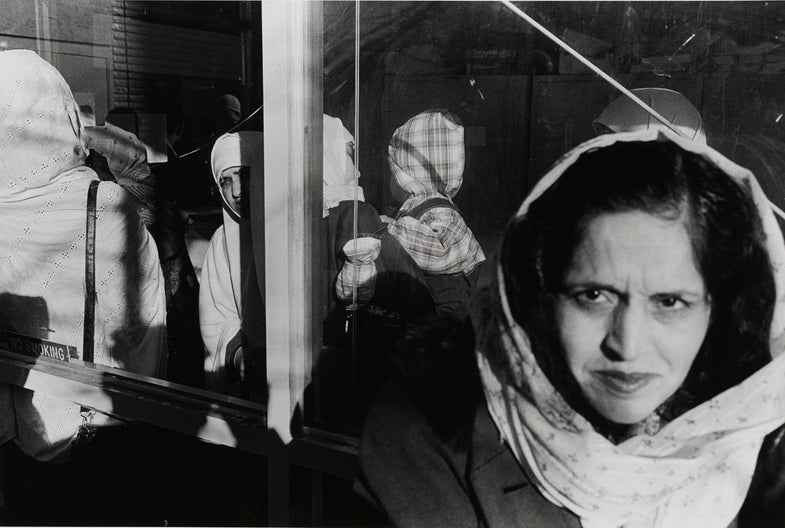Muslim Life in New York City
The Museum of the City of New York responds to the travel ban


In politically tumultuous times, cultural institutions become beacons of resistance. For nearly the entire campaign season and especially since the new administration took office, anti-Muslim rhetoric has reached an all-time high. Muslim in New York: Highlights from the Photography Collection is a new exhibition at the Museum of the City of New York, and it is a direct response to the Islamophobia that has run rampant since the president took office. This is a show that it seeks to humanize a community that has been in the United States since the beginning. Curated from the museum’s permanent collection, the exhibition features 34 images of Muslim New Yorkers across the 20th and 21st centuries by the photographers Mel Rosenthal, Ed Grazda, Alexander Alland, and Robert Gerhardt.

“It was our fastest exhibition ever. Two and a half weeks from concept to presentation,” says Sarah Henry, the chief curator for the museum, when asked about the urgency of this show. “It grew out of conversations that we had among museum staff about how we could usefully and valuably contribute to the conversations that are going on in the context of political events right now.”
Taken between 1940 and today, the images form a composite portrait of Muslim life in New York City. The monochrome images show Muslim New Yorkers both in their cultural enclaves and in the fabric of city life. New York City is large; it contains multitudes. Go on a long walk, and you might find yourself traveling through several different countries. This exhibition is a testament to that. The most striking images are ones that show the overlap between Muslims and the city.

In a 2011 image by Gerhardt, a boy considers the camera. He’s wearing a Vans t-shirt and he’s holding a basketball. Ostensibly, he’s taking a break from playing, and the caption tells us he’s playing before Friday prayers. He’s the quintessential New York kid and a Muslim—or rather, he’s just the quintessential New York kid.

In a 2012 image, also by Gerhardt, an NYPD traffic officer in his uniform is kneeling in a mosque. His head is bowed and his hands are on his thighs. The officer is there purely to meet his spiritual obligation. People are standing to the left and right of him. It is a quietly powerful image and deeply meditative in how it depicts an unguarded moment.

In a 1995 image by Ed Grazda, a group of Muslim men pray in the middle of the street at the intersection of East 41st Street and Park Avenue. Almost all of them are bent forward, their hands and foreheads touching their prayer mats. It is a public display of faith in a city that welcomes all faiths.
Gotham is a place where you can be a part of and apart from it. There is a collective identity and space for individuals. The pictures in Muslim in New York speak to both.

In a 1940 image by Alexander Alland, a group of Turkish schoolchildren practice Turkish. All of them have their workbooks open to the same page. It’s a picture that easily could have been taken in Istanbul or Ankara, but it’s in New York City where it’s likely that many other schoolchildren of a similar age would have been practicing their respective family languages.

In the above image taken by Mel Rosenthal in 2001, we see a classic New York scene: the Halal food cart, its owner and a customer. The Halal food card is as ubiquitous as pizza, bagels, and those “Dan Smith Will Teach You Guitar” posters. It’s a simple image but remarkable in how it captures just how seamlessly different cultures intersect in New York.
The exhibit is perhaps best understood in the context of the museum as a whole, which is dedicated to showing the development of New York City from its origin to the present day. To live in New York is to regard diversity as the norm. Any given subway ride is like an informal meeting of the United Nations. It is impossible to think of New York City without immigrants—it wouldn’t exist at all. There’s something refreshing about the exhibit in how it depicts a maligned and deeply misunderstood community as purely ordinary. Muslim New Yorkers across these pictures are living their lives as best they can. They go to work and school. They pray. They play basketball. They go to weddings and parties.
While it isn’t comprehensive, the exhibition serves as a modest reminder that, at least as far as New York City is concerned, Muslims have always been here. They have contributed to and shaped the ethos of this place, and they are an indelible part of what makes New York New York. This city is a place where culture is both preserved and shared. Through 34 photographs, the exhibition serves as a much-needed reminder that to be a Muslim in New York is simply to be a New Yorker.
Muslim in New York will be on view through July 30.